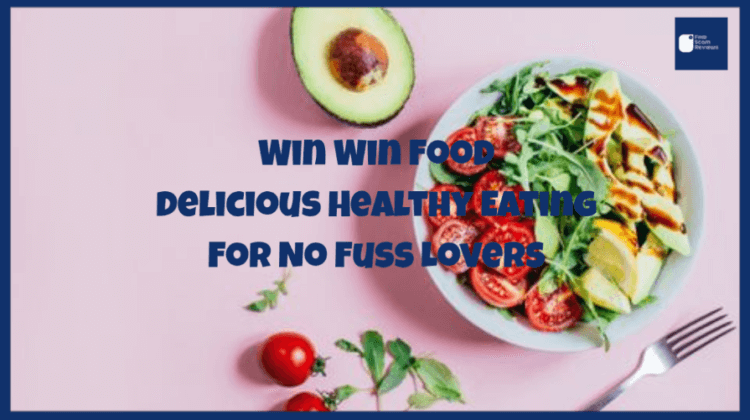
The Best 19 Win Win Food Delicious Healthy Eating for No Fuss Lovers
We all know the feeling: we want to be healthy, but we also want to eat delicious food that’s easy to prepare. However, these two desires often seem at odds with each other. Unhealthy fast food is quick and easy, while healthy meals often require more time and effort.
But it doesn’t have to be this way! There are plenty of healthy and delicious foods, and we’ve compiled a list of 19 of the best. From breakfast to fast healthy dinner ideas, we’ve covered you with healthy eating recipes and ideas for meals that will leave you satisfied and nourished. So what are you waiting for? Get cooking!

“Healthy eating is a way of life, so it’s important to establish routines that are simple, realistically, and ultimately livable.” – Horace
The Benefits of Win Win Food
It can be hard to switch to a healthier diet in a world filled with processed and unhealthy foods. But did you know that there are many benefits to eating “win-win foods”?
Win-win foods are those that are good for you and good for the environment. These foods are typically unprocessed and locally gr, with a lower carbon footprint than other foods. Eating win-win foods can help you improve your health, reduce your impact on the environment, and support the local economy.
So why not give win-win foods a try? Your body and the planet will thank you for it!
The Top 19 Win Win Food
If you’re looking for foods that are good for you and the planet, look no further. Here are 20 of the best win-win foods you can feel good about eating well recipes.
1) Avocados
Avocados are a great source of healthy fats, fiber, and vitamins. They’re also one of the most drought-resistant crops, making them an excellent choice for sustainable agriculture.
2) Bananas
Bananas are nutritious and delicious fruit that packs a lot of potassium. They’re also grown water-efficient, making them an excellent choice for those looking to consume more sustainable foods.
3) Beans
Beans are nutrient-dense and very drought-resistant food. This makes them an excellent option for sustainable agriculture.
4) Berries
Berries are a great source of antioxidants and fiber. They’re also grown water-efficient, making them an excellent choice for those looking to consume more sustainable foods.
5) Cabbage
Cabbage is a nutrient-rich, very drought-resistant vegetable. This makes it an excellent option for sustainable agriculture.
6) Carrots
Carrots are a great source of fiber and vitamins. They’re also grown water-efficient, making them an excellent choice for those looking to consume more sustainable foods.
7) Chia Seeds
Chia seeds are an excellent source of omega-3 fatty acids, fiber, and antioxidants. They’re also grown water-efficient, making them a perfect choice for those looking to consume more sustainable foods.
8) Coconut Oil
Coconut oil is a healthy fat in many different ways. It’s also sourced from coconuts, one of the most drought-resistant crops, making it an excellent choice for those who consume more sustainable foods.
9) Eggs
Eggs are a great source of protein and other nutrients. They’re also one of the most water-efficient foods, making them an excellent choice for those who consume more sustainable foods.
10) Hemp Seeds
Hemp seeds are an excellent source of protein, fiber, and omega-3 fatty acids. They’re also grown water-efficient, making them a perfect choice for those looking to consume more sustainable foods.
11) Kale
Kale is a nutrient-dense leafy green that is also quite water-efficient. It’s an excellent choice for those looking to consume more sustainable foods.
12) Lentils
Lentils are a great source of protein and fiber. They’re also one of the most water-efficient foods, making them an excellent choice for those who consume more sustainable foods.
13) Mushrooms
Mushrooms are a great source of antioxidants and other nutrients. They’re also one of the most water-efficient foods, making them an excellent choice for those who consume more sustainable foods.
14) Oats
Oats are an excellent source of fiber and other nutrients. They’re also one of the most water-efficient crops, making them a perfect choice for those who consume more sustainable foods.
15) Quinoa
Quinoa is an excellent source of protein and other nutrients. It’s also one of the most water-efficient crops, making it an ideal choice for those who consume more sustainable foods.
16) Rice
Rice is an excellent source of energy and other nutrients. It’s also one of the most water-efficient crops, making it a perfect choice for those who consume more sustainable foods.
17) Sweet potatoes
Sweet potatoes are an excellent source of fiber and other nutrients. They’re also one of the most water-efficient crops, making them a perfect choice for those who consume more sustainable foods.
18) Tomatoes
Tomatoes are a great source of antioxidants and other nutrients. They’re also one of the most water-efficient crops, making them an excellent choice for those who consume more sustainable foods.
19) Turnips
Turnips are a great source of fiber and other nutrients. They’re also one of the most water-efficient crops, making them an excellent choice for those who consume more sustainable foods.
ALSO READ: Foods That Activate Brown Fat – The Best 17 Healthy Foods
How to Prepare Win Win Food

In life, there are many opportunities to create win-win situations. But did you know that you can also create win-win foods? Yes, it’s true! You can make foods that are nutritious, delicious, and good for the environment.
Here are some tips on how to make win-win foods:
Choose local, organic, and seasonal ingredients.
First, we should try to choose local and organic foods whenever possible. Local foods are fresher and tastier and have a less environmental impact than foods shipped from far away.
Organic foods are also excellent for our health and the environment, as they are free of harmful pesticides and other chemicals.
Buy food from local farmers’ markets or join a community-supported agriculture (CSA) program.
Buying food from local farmers’ markets or joining a community-supported agriculture (CSA) program is a great way to get fresh, sustainable, and often organic produce. It supports small businesses and helps to build strong communities.
Cook with sustainable methods like solar cooking or a pressure cooker.
Sustainable cooking methods like solar cooking or a pressure cooker use less energy than traditional methods and can help save money on utility bills. They also tend to produce tastier food, as the flavors of the ingredients are preserved better.
Save food scraps and use them to make compost or feed animals.
Food scraps can be saved and used to make compost or feed animals. This is a great way to reduce waste and use otherwise unusable materials. It also helps to fertilize gardens and improve soil health.
Use waste products from other food processes to make new foods.
For example, you can use potato skins to make chips or use leftover coffee grounds to make ice cream.
Sharing is caring.
Share your recipes with others so they can make win-win foods, too
How to Balance Your Plate with Win Win Food
Eating a balanced diet is vital for maintaining good health, but knowing how to balance your plate can be challenging. Many people think they need to choose foods low in calories or fat, but this isn’t necessarily the case. Instead, it would be best if you focused on selecting win-win foods that are good for you and the planet.
Here are some tips on how to balance your plate with win-win foods:
1) Fill half of your plate with fruits and vegetables.
The United States Department of Agriculture (USDA) recommends that adults fill half their plates with fruits and vegetables at each meal. This includes both fresh and frozen options. Aim for various colors and types of fruits and vegetables to get the most benefit.
Filling half of your plate with fruits and vegetables is an excellent way to get your body’s nutrients. These nutrients include vitamins, minerals, and fiber. They can also help you lower your risk for chronic diseases, such as heart disease, type 2 diabetes, and some types of cancer.
So next time you’re at a meal, think about how you can fill half of your plate with fruits and vegetables. It’s a simple way to boost your health.
2) Choose whole grains over refined grains.
Whole grains are healthier than refined grains because they contain more fiber and nutrients. Fiber helps to keep us regular and can lower cholesterol and blood sugar levels. The nutrients in whole grains can also help to protect our hearts and bodies against disease.
So if you’re looking for a healthier way to fuel your body, choose whole grains over refined grains. Your body will thank you for it!
3) Include a source of lean protein.
Protein is essential for repairing tissues, building muscle, and maintaining healthy body weight. A well-rounded diet includes a source of lean protein. This could be grilled chicken, fish, tofu, legumes, or eggs. Including lean protein with each meal will help to keep you satisfied and help you reach your nutrient goals.
4) Opt for plant-based fats.
Regarding heart health, experts recommend opting for plant-based fats over animal-based fats. Plant-based fats are found in foods like nuts, seeds, avocados, and olives. These fats can help lower cholesterol and protect against heart disease. On the other hand, animal-based fats are found in meats and dairy products. These fats can raise cholesterol and increase the risk of heart disease.
So if you want to protect your heart, choose plant-based fats over animal-based fats. Your heart will thank you for it!
5) Drink water or unsweetened beverages.
Water is essential for our bodies to function correctly. It helps to regulate our body temperature, carries nutrients to our cells, and helps to flush out toxins. Most of us know that we should drink eight glasses of water daily, but many don’t reach that goal.
Unsweetened beverages like tea and coffee can also be good for you, as long as they’re not loaded with sugar. These drinks can help hydrate you and provide you with some essential antioxidants.
So next time you’re reaching for a drink, choose water or an unsweetened option to keep your body healthy and hydrated.
By following these tips, you can ensure you’re getting the nutrients you need while also doing your part to protect the planet.
7-day Healthy Eating Plan
A healthy diet is vital for a variety of reasons. It can help you maintain a healthy weight, reduce your risk of chronic diseases, and feel best. However, making significant changes to your diet can be daunting. Here is a beautiful plan to get you started.
On day 1, focus on fruits and vegetables. For example, start your day with a fruit smoothie for breakfast, eat a salad or vegetable soup for lunch, and enjoy roasted vegetables or a vegetable stir-fry for dinner. Include at least 2 cups of fruit and 2.5 cups of vegetables per day.
On day 2, focus on whole grains. Make sure that half of the grains you consume are whole grains. Start your day with oatmeal or whole grain toast for breakfast, enjoy a quinoa or brown rice bowl for lunch, and round out your day with whole wheat pasta or barley risotto for dinner.
On day 3, focus on lean protein sources. For example, grilled salmon or roasted chicken breast makes a great entree, while tofu spinach enchiladas or black bean soup make tasty and satisfying vegan options. Include fish, poultry, beans, tofu, and eggs in your diet today.
On day 4, focus on healthy fats. Incorporate avocados, nuts, seeds, olive oil, and coconut oil into your diet. For example, add sliced avocado to your breakfast toast or enjoy a small handful of nuts as a snack. Use olive oil to roast vegetables or make a salad dressing from scratch. And finish your day with homemade popcorn in coconut oil for a fun and healthy snack.
On day 5, focus on calcium-rich foods. Be sure to include dairy products like milk and yogurt and calcium-fortified alternatives like soy milk and almond milk in your diet today to reach the recommended 1000 mg of calcium per day. For example, drink milk with breakfast cereal or oatmeal; enjoy yogurt topped with fruit or granola for a snack; have cheese on your sandwich at lunch. And cook up hearty spinach and ricotta lasagna for dinner tonight!
Rounding the week on days 6 and 7, aim to eat mindfully and exercise regularly. This means paying attention to your hunger cues and listening to your body when you feel full. It also means making time for physical activity every day.
Try 30 minutes of moderate aerobic exercise like walking or biking most days this week. And don’t forget strength training too – two 10-15 minute weekly sessions are ideal!
Finally, cut back on processed foods, sugar, and salt; limit alcohol to one drink daily, and stay hydrated by drinking plenty of water throughout the day. By following these simple guidelines, you can jumpstart Your journey to better health!
ALSO READ: The 4 Truth About Pineapple Juice Wisdom Teeth: Is There A Link?
FAQ about Win Win food
How can I eat healthily when away?
Eating healthy can be challenging when you’re away from home, whether traveling for business or pleasure. But with some planning, it is possible to eat healthy meals even when you’re on the go.
Here are a few tips to help you eat healthy when you’re away from home:
1. Pack your healthy snacks and meals.
This way, you’ll have healthy options available when you get hungry.
2. Research restaurants in advance.
Look for restaurants that offer healthy menu options.
3. Make intelligent choices when you’re eating out.
Order dishes that are grilled, baked or steamed instead of fried.
4. Limit your alcohol intake.
Alcohol can quickly add empty calories to your diet.
5. Stay active.
Get up and move around as much as you can. Taking a walk after meals can help you stay on track.
How can I eat healthy when super busy?
It can be tough to eat healthy when you’re always on the go. But with some planning and effort, it is possible to eat healthy even when you’re super busy. Here are a few tips to help you make healthy choices when you’re short on time:
Plan ahead. Ensure you have healthy snacks and meals so you’re not tempted to eat junk food.
1. Eat regularly. Skipping meals can make you more likely to make unhealthy choices when you do eat.
2. Keep it simple. Choose healthy foods that are easy to prepare.
3. Be prepared. Pack a healthy lunch or snacks if you know you’ll be out all day.
4. Use technology. Plenty of helpful recipe and nutrition tracking apps can help you make better choices.
Following these tips, you can make healthy choices without feeling deprived or like you’re on a diet.
How can I eat healthily without access to my kitchen?
There are a few ways to eat healthily without access to your kitchen. One way is to find healthy foods that don’t require cooking, such as fruits, vegetables, and certain types of meat. You can also look for recipes that can be made with minimal kitchen equipment, such as a microwave or a toaster oven.
Another option is to find restaurants that serve healthy meals. If you have a kitchen but are limited on time, you can also find healthy recipes that can be made quickly.
No matter your situation, there are plenty of ways to eat healthily without access to your kitchen. With creativity and effort, you can ensure you’re getting the nutrients your body needs.
How can I lose weight when I have no time to cook?
Many factors play into weight loss, including diet and exercise. But for busy people who don’t have time to cook, weight loss can seem like an impossible task. Luckily, there are some simple tips you can follow to lose weight even when you don’t have time to cook.
First, you need to make sure you’re eating the right foods. Choose foods high in protein and fiber and low in sugar and fat. This will help you feel fuller and longer and give you the energy you need to make it through your busy day.
Second, you need to make sure you’re getting enough exercise. Even if you can’t make it to the gym daily, you can still exercise by walking more and taking the stairs instead of the elevator.
Finally, remember that weight loss is a journey, not a destination. Don’t get discouraged if you have a bad week or two because everyone has setbacks from time to time. Just get back on track and keep going!
How can I eat without gaining weight?
Most people think that eating less is the only way to lose weight. However, this is not always the case. Several factors can influence weight gain, and not all of them have to do with food. For example, stress can lead to weight gain, as can certain medications.
That said, there are some things you can do to help prevent weight gain. One is ensuring you eat a balanced diet that includes all the major food groups. Another is to get regular exercise. And finally, don’t forget to watch your portion sizes. Just because you’re not eating less doesn’t mean you can eat more.
With a little effort, you can still enjoy your food without worrying about gaining weight.
How can I eat well with no money?
While a tight budget may limit your options for eating out, there are still plenty of ways to eat well without breaking the bank.
One of the simplest ways to save money on food is to cook at home more often. This doesn’t mean you have to spend hours in the kitchen every day – plenty of quick and easy recipes can be made with just a few ingredients.
Another way to save money is to choose less expensive ingredients when cooking. For example, buying fresh produce that is in season or opting for frozen or canned goods over new items can help to keep costs down.
Finally, take advantage of grocery store sales and coupons – planning your meals around what’s on sale can help you save significant money over time. By following these tips, you can eat well without spending much money.
What should I eat when no one is at home?
When you’re home alone, it can be tempting just to eat whatever is convenient or whatever you’re in the mood for. However, it’s essential to be mindful of what you’re eating and ensure you get the nutrients your body needs.
A balanced diet is a key to maintaining your health, and that’s just as true when you’re eating by yourself as when you’re eating with others. A simple grilled cheese sandwich or a PB&J are always good options if you’re unsure what to make.
You can also try making a quick salad or wraps with whatever vegetables and protein you have on hand. And don’t forget to drink plenty of water! Staying hydrated is essential for keeping your body healthy and functioning correctly.
So next time you’re home alone, take the time to make yourself a nutritious meal that will give you the energy you need to get through the day.
ALSO READ: Food that makes people sick will often: Top 5 Signs and MORE
Bottom line
In conclusion, eating healthy does not have to be a chore. There are many delicious and nutritious foods that you can enjoy without having to spend much time cooking or fussing over meal prep. By making intelligent choices and focusing on your health, you can easily enjoy healthy, delicious meals that will help you stay healthy and happy.
